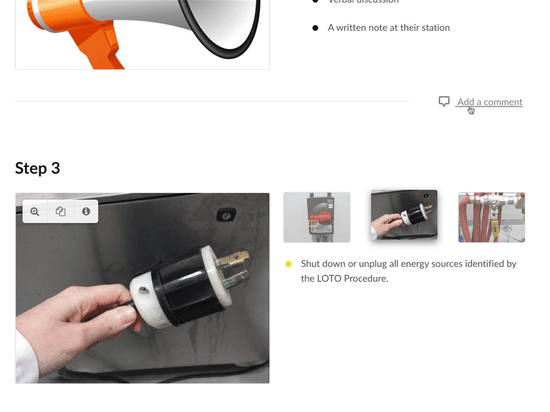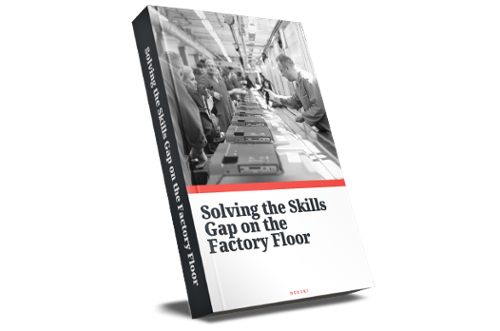
Training
7 min read
5 Ways to Fix the Skills Gap on the Factory Floor

Properly addressing the skills gap takes time. But before you start forming an internal task force or scheduling strategy meetings, consider what impact you can have on the skills gap right now.
With the advancement of easy-to-use workforce training tools, you can start fixing the skills gap on the factory floor — today.
Here are five easy wins that will ensure frontline workers have the information they need to complete essential work.
1. Create Two-Way Mentorship Programs
The way information flows between new and experienced workers is changing. Historically, companies have leaned heavily into on-the-job (OTJ) training. This practice, where a new worker (or group of workers) shadows the best available expert, is non-standardized and difficult to scale. Workers from different OTJ trainers learn opposing methods for doing the same procedure.
Long-standing experts who act as OTJ trainers are often averse to learning new technology. These experts have the bulk of the company’s tribal knowledge in their head, and they’re in no hurry to transfer it into a documented format. That’s where reverse mentoring comes into play.
When you pair experts with new-hires for OTJ training, the knowledge exchange should go both ways. Task your expert with passing on every piece of tribal knowledge they know for the given procedure. Task your new hire with capturing and documenting that knowledge into a digital standard operating procedure. This allows the expert to flex their knowledge and simultaneously learn how to digitally capture documented procedures. In turn this creates a bond between your new and old workers while scaling expertise across your entire company.
Clip from The Voices of Manufacturing Podcast episode 14 with Kiley Becker
2. Use Videos to Capture Process Knowledge
With today’s digital-first generation, the format of the traditional standard operating procedure (SOP) is changing. New operators entering the workforce are used to watching video instructions for everything; cooking, repairing, renovating – the list is endless.
They also expect their work instructions in video format.
Meanwhile, long-standing experts rarely reference the SOP binder anymore – they know their procedures better than they know how to operate their own flip-phone.
It’s important that these two generations collaborate in the workplace to capture experts completing procedures on video, before the guard changes and decades of tribal knowledge walk out the door.
3. Turn Basic Knowledge into Training
There is a common segment of knowledge that’s overlooked when creating training programs — the basics. You might be surprised to find out that many workers don’t know the function of basic parts or devices in your operations.
A recent example shared by a customer demonstrates the danger of this assumption:
"While walking past a worker he noticed they were using a hammer on a sealed bearing. Anyone familiar with bearings knows this is how you end its life cycle, but this worker was in the midst of a repair.
After a brief discussion and surveying some other workers, it became obvious that not everyone knew what a bearing was for, how it should be maintained, or how to extend its life cycle.
One of the lead maintenance technicians was able to quickly create training modules to address this knowledge gap, which in turn led to recording training for all other repairs in the facility."
Luckily, this knowledge is even easier to capture and distribute than your traditional processes. You can use video to capture expert knowledge and train your workforce to those standards the same day.
The ability to train isn’t limited to advanced procedures. The basics are something you can rapidly build training around; from overviews (function, features, maintaining, etc) of every tool, to introductions of different factory departments, lines, or equipment.
4. Collect Undocumented Improvements
Many workers see opportunities for process improvement every day. Front line workers withhold that information if they feel it’s typically ignored or fear of rocking the boat. In the end, workers integrate improvements within their daily process as informal “shortcuts”.
That information (good or bad) doesn’t make its way into the documented procedures. This leads to quality issues, confused trainees, and a workforce that doesn’t feel ownership over their daily work.
Instead, give workers the ability to provide controlled feedback on the processes they run. This not only supports continuous improvement, but also fosters a culture where operators take pride in the procedures they are responsible for. At the same time, new-hires are able to offer fresh perspectives when viewing procedures for the first time.

To do this effectively you need to be able to capture feedback digitally, on the floor where operators are working. As an example, Dozuki offers two different ways to support this – Answers which enables a company-wide troubleshooting platform and CI Comments which allows feedback to be posted on individual steps of documented procedures.
5. Give New Hires Access to Digital Tools
The industrial environment can be overwhelming to new workers. For many new hires, the first week on the job is when career decisions are made. Seeing recruits quit a week or two after being hired is more common today than ever before.
With a wave of new people entering the workforce, it’s becoming critically important that they feel supported and confident, very early in their work experience. The grand scale of factories and warehouses are intimidating and it’s management’s responsibility to support new employees during this critical stage.
Provide the incoming generation with modern tools they can understand. The “Youtube generation” is entering your workforce and if you are failing to provide them with a training experience they’re familiar with, you’ll see mass attrition of new hires.
Give workers access to digital training (ex. video work instructions) through mobile devices such as smartphones or tablets. Familiar digital tools are an easy way to provide a security blanket to new hires — reducing turnover in the process.
Accessible information also creates confidence. Even if the tablet is only temporarily allocated, building trust early on will serve as a strong foundation. Workers will feel that they can rely on internal resources, which improves both standardization and quality as a result.
Topic(s):
Training
Solving The Skills Gap

Download our practical guide for strategies and actionable tips on how to capture and amplify knowledge across operations.
Related Posts
View All Posts
Work Instructions
How to Get More Out of Your Work Instructions
6 min read
When leveraged properly, standardized work instructions can transform operational efficiency, quality management, employee performance, and more. All industrial businesses...
Continue Reading
Training
How to Capture Expert Knowledge Before it's Lost
6 min read
It’s no secret. Manufacturers are coping with a massive wave of retirements. With over a quarter of the workforce over the age of 55, many workers are leaving their jobs with...
Continue Reading
Product
Recent Mobile App Updates
5 min read
Dozuki is a frontline work training platform for industrial companies who depend on operators to meet production standards. Our mobile app is used by frontline operators to ...
Continue Reading



